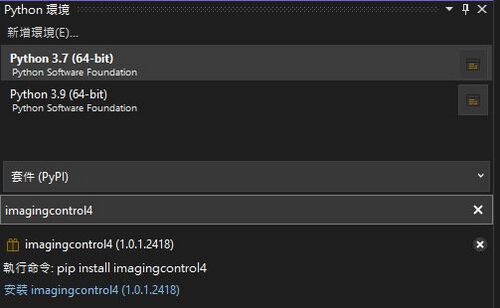使用Python 與 The Imaging Source 相機入門
跳至導覽
跳至搜尋
使用 Python 以及 C、C++ 和 C#,您可以完成以下操作:
- 顯示視訊串流
- 手動和自動捕捉單張影像
- 擷取視訊
- 設定所有相機屬性
Windows:
- 安裝 Imagingcontrol4 輸入指令安裝Imagingcontrol4或是在Visual Studio Python環境裡選擇安裝imagingcontrol4套件,如下圖:
python3 -m pip install imagingcontrol4

- 驅動 GigE Vision 相機 GenTL Producer / USB3 Vision 相機 GenTL Producer / 非 GenICam 相機的 GenTL Producer (BETA)
擷取影像的範例:
import imagingcontrol4 as ic4
ic4.Library.init()
# Create a Grabber object
grabber = ic4.Grabber()
# Open the first available video capture device
first_device_info = ic4.DeviceEnum.devices()[0]
grabber.device_open(first_device_info)
# Set the resolution to 640x480
grabber.device_property_map.set_value(ic4.PropId.WIDTH, 640)
grabber.device_property_map.set_value(ic4.PropId.HEIGHT, 480)
# Create a SnapSink. A SnapSink allows grabbing single images (or image sequences) out of a data stream.
sink = ic4.SnapSink()
# Setup data stream from the video capture device to the sink and start image acquisition.
grabber.stream_setup(sink, setup_option=ic4.StreamSetupOption.ACQUISITION_START)
try:
# Grab a single image out of the data stream.
image = sink.snap_single(1000)
# Print image information.
print(f"Received an image. ImageType: {image.image_type}")
# Save the image.
image.save_as_bmp("test.bmp")
except ic4.IC4Exception as ex:
print(ex.message)
# Stop the data stream.
grabber.stream_stop()
Linux:
- 安裝:請至The Imaging Source官網,「軟體開發套件」一章。 根據您的 Linux 平台下載「tiscamera」。
- 文獻參考 https://www.theimagingsource.com/en-us/documentation/tiscamera/
- 範例 https://github.com/TheImagingSource/tiscamera/tree/master/examples/python / https://github.com/TheImagingSource/Linux-tiscamera-Programming-Samples/tree/master/python
程式範例:
import time
import sys
import gi
gi.require_version("Gst", "1.0")
from gi.repository import Gst
def main():
Gst.init(sys.argv) # init gstreamer
serial = None
pipeline = Gst.parse_launch("tcambin name=bin "
" ! videoconvert"
" ! ximagesink sync=false")
# retrieve the bin element from the pipeline
camera = pipeline.get_by_name("bin")
# serial is defined, thus make the source open that device
if serial is not None:
camera.set_property("serial", serial)
pipeline.set_state(Gst.State.PLAYING)
print("Press Ctrl-C to stop.")
# We wait with this thread until a
# KeyboardInterrupt in the form of a Ctrl-C
# arrives. This will cause the pipline
# to be set to state NULL
try:
while True:
time.sleep(1)
except KeyboardInterrupt:
pass
finally:
pipeline.set_state(Gst.State.NULL)
if __name__ == "__main__":
main()